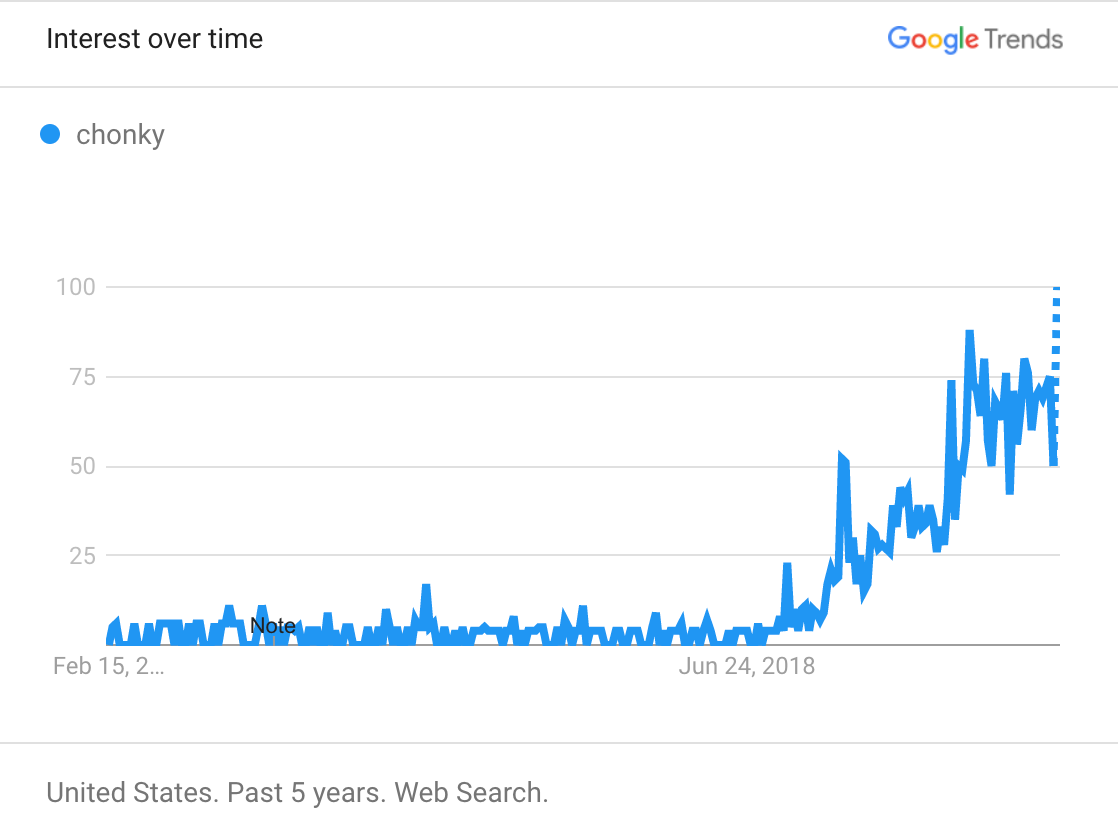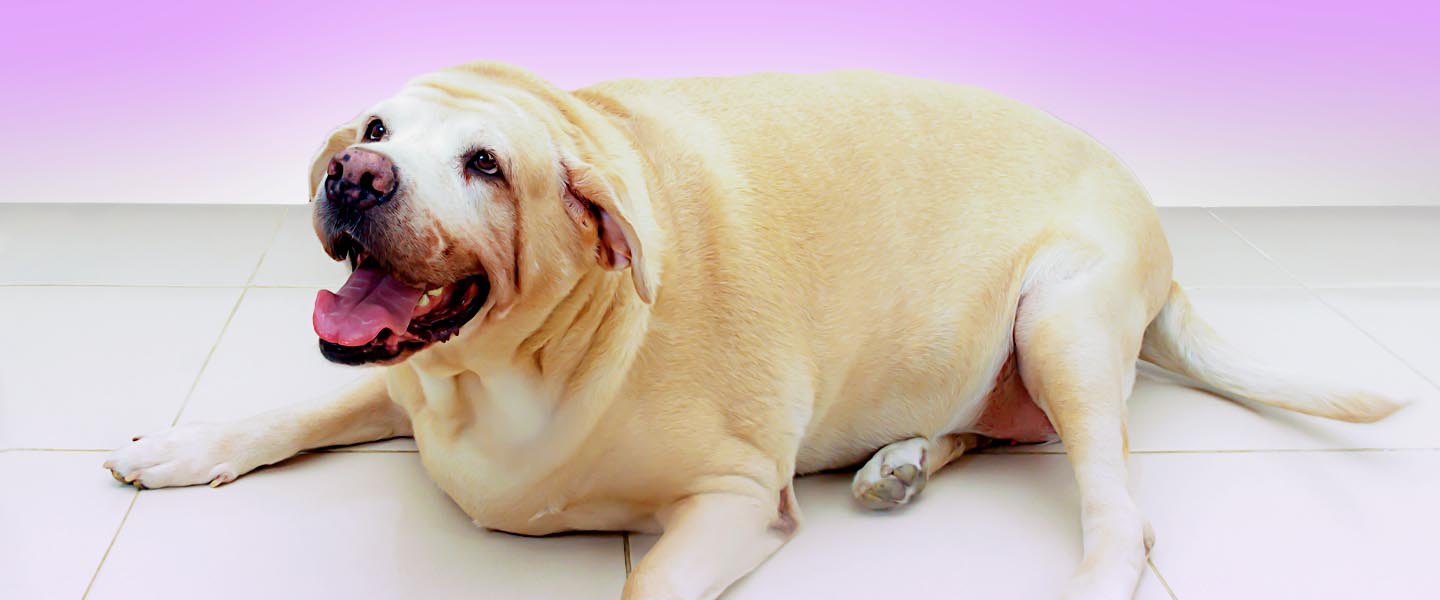When Sean Flannery, a 43-year-old software engineer, and his family started fostering an elderly sheltie named Fox last fall, it wasn’t long before his three children (ages 12, 9 and 5) changed the dog’s name to “Thicc.” Flannery actually had to talk the kids out of calling the sheltie Piggy, on account of how he pushed his food bowl around with his nose like a rooting pig. As a fluffier breed, Thicc wears his extra pounds deceptively well and looks like he’s all hair — until you try to lift him and “throw out your back,” Flannery jokes.
“He’s 100 percent overweight,” Flannery tells me. (Thicc is currently 28 pounds, whereas an average male sheltie of his size weighs 16 to 20 pounds.) “When you pick him up, it feels like someone has thrown a boulder into your hands.”
There isn’t a lot Flannery can do about it. Thicc showed up overweight and cannot exercise because of arthritis and hip problems. The family limits what they feed him, but Thicc is probably stuck with his boulder body. Not that the family — gentle chiding notwithstanding — minds. They subscribe to the belief that a well-fed dog is a happy dog and a happy dog is a good dog. This is the case for most dog owners, explains Sara Ochoa, a Texas-based veterinarian and consultant for DogLab.com. “It comes from people thinking fat animals are cute, or that food and treats are a good way to show your dog that you love them.”
Not surprisingly, then, we currently find ourselves in the age of pet body positivity — bolstered, in large part, by pet influencers, Wide Dog and El Perrito Super Gordito memes and countless listicles celebrating overweight dogs like Thicc.
Sure, more than half of dogs are technically considered overweight — a number that’s only increased over the past decade — but like the Flannerys, we love our thicc good boys and girls so much that we had to invent a word to properly express our affection for them: chonky. In August 2018, the “chonk chart,” otherwise known as the Oh Lawd He Comin’ meme, was posted on Facebook, and though it was originally about cats, it was immediately appropriated by dog people. Soon, chonky boys and girls were everywhere, winning the National Dog Show, documenting their pregnancy journeys and competing in plus-size modeling competitions.

Chonky is more than a fun addition to our lexicon: It’s another excuse to treat dogs like people. Which makes sense, given our current moment: More and more millennials are delaying parenthood or opting out of it completely, pivoting to raising pups in expensive clothes instead. At the same time, people are starting to slowly crawl away from a diet-, weight- and size-obsessed culture to a more inclusive one. And some of this inclusiveness has trickled down to our dog-children.
Case in point: When Christine Hnath, a 33-year-old project manager, was taking the train from New York City to visit her parents in Connecticut, she didn’t expect her Chihuahua-mix rescue Lucy to be commended for her nontraditional body type. But sure enough, an older woman approached her and said, “It’s so refreshing to see a Chihuahua of a healthy weight.”
“I was taken aback because when I got her she was emaciated, so I don’t know what she’s supposed to look like at a normal size,” Hnath says. “But it felt weird to be complimented on that, like my dog’s body should be a point of pride.”
More largely, anti-diet advocacy groups like the Moderation Movement have used dogs to teach children about size diversity and body respect since as early as 2016. “One way you can explain size diversity and acceptance to young children is to point out how different dogs are,” the organization has posted to Facebook. “Some are long and lean, some have a lot of muscle, others are round and soft, some tiny, some large, and we never expect them to be anything other than how they were born.” Professional dog-sledder Blair Braverman echoed similar sentiments this past summer in a series of tweets about how her sled dogs taught her that “all bodies are different… in a bone-deep, beautiful, complicated way.”
Y’all, having sled dogs has been so good for my body image. And not because mushing is a joy-filled, physical outdoor activity, although that’s true. It’s actually something much simpler than that. pic.twitter.com/PJDMtBF0Bv
— Blair Braverman (@BlairBraverman) July 13, 2019
Dogs also have been used to debunk much of the flawed research that inaccurately suggests smaller, thinner bodies are healthier. Sophia Carter-Kahn, host of the She’s All Fat podcast, cites the the Association for Size Diversity and Health’s video on “poodle science,” as an effective example. It breaks down the issue of body diversity being underrepresented in the data, but in terms of chonky dogs: “The problem is, poodles think that every other kind of dog is just a really big or really small or really fat poodle, when actually, the other dogs aren’t even poodles at all — they’re terriers and mastiffs and greyhounds and Labs.”
As much as this makes sense for teaching children (who are developmentally predisposed to loving animals) about body positivity, using dogs in such a manner for everyone else underscores a larger issue with the cause: that, to begin with, few people are willing to talk about size acceptance in a direct way. “I wish that people were comfortable talking about fat human bodies as well, and that we didn’t have to use a roundabout way to tell them that everyone deserves respect,” Carter-Kahn says.
There is, naturally, a counter-narrative as well: namely, that chonkiness shouldn’t be celebrated but considered a type of animal abuse. (For evidence see the Facebook groups Stop Calling Obese Animals “CHONKY” and Chonky Culture Is Animal Abuse, plus numerous Reddit threads). Which, in turn, has inspired a second chonkiness trend: chonky dogs documenting their weight-loss journeys on Instagram. It’s entirely possible, then, that we’ve created a big chonky monster. After all, Ochoa warns, “Overweight dogs are more prone to arthritis and heart problems.” And besides the emotional costs of a sick pup this presents, it also comes with real ones — both in terms of vet bills and weight-loss kibble, which is typically more expensive than regular pet food.
“Chonky” cats and dogs aren’t cute, they’re unhealthy from unpopularopinion
As for what’s considered overweight for a dog, it depends on a combination of three things: breed, height and age. Subsequently, an overweight dog ends up being any dog that weighs 5 to 19 percent more that their vet advises. Chonkiness obviously is more difficult to define, but as the original meme suggests, it occurs on a scale and isn’t necessarily reflective of overall health (good, bad or otherwise).
For her part, Lucy the Chihuahua mix has a clean bill of health from her veterinarian, and Hnath intends to keep it that way. “I don’t want her to be unhealthy, I want her to live a long life,” Hnath tells me. At this precise moment, Lucy jumps into Hnath’s arms while she’s standing — something a dog in poor health clearly couldn’t do — as if to bring the point home.
Meanwhile, Thicc’s vet is more concerned with his age than his weight, but his health has improved significantly since moving in with the Flannerys. Admittedly, Flannery laughs when I mention the burgeoning dog body positivity movement Thicc is unknowingly a part of. Flannery had never heard of the term “chonky” until I brought it up, yet he concedes that his children have learned positive things from Thicc and his nontraditional shape. “My kids say he does teach them that it’s important to eat your vegetables, and if you only eat meat like him, you won’t be able to get up on the couch,” Flannery explains.
In the end, the Flannerys’ distance from social media, memes, chonk culture and dog body positivity might be exactly what makes them the most reasonable representation of it. Because most chonky dogs aren’t influencers, activists or blights on the pet health-care system. They’re usually just rescue dogs who are so psyched to eat they occasionally overdo it. And that’s really what makes them so lovable. “My youngest,” Flannery says, “thinks Thicc is so beautiful and handsome that she wants to marry him.”

